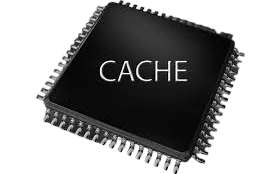Cache Memory

Cache Memory
Cache memory is a small-sized, high-speed memory that provides faster access to the CPU than main memory (RAM). It plays an important role in enhancing system performance by keeping pace with the CPU’s speed and ensuring faster data retrieval.
What is Cache Memory?
Cache memory is accessed exclusively by the CPU and can be a reserved portion of the main memory or a separate storage unit. It stores frequently used data and instructions, ensuring that the CPU can access them quickly when needed. By reducing the need to access the slower primary memory (RAM), cache memory acts as a buffer between the CPU and RAM, significantly increasing system performance.

Types of Cache Memory
1. L1 Cache (Level 1 Cache)
Location: Built directly into the CPU.
Purpose: Provides the fastest access to instructions and data for the CPU.
Features:
Each CPU core has its own L1 cache.
Operates at the same speed as the CPU.
The memory size typically ranges from 2 KB to 64 KB.
Subtypes:
Instruction cache: Stores CPU instructions.
Data cache: Stores data required by the CPU.
2. L2 cache (level 2 cache)
Location: Can be located inside or outside the CPU.
Purpose: Provides additional storage for data and instructions if the L1 cache is insufficient.
Features:
Can be dedicated to individual CPU cores or shared among them.
Connected to the CPU via a high-speed bus when located externally.
Memory size ranges from 256 KB to 512 KB.
Slower than L1 cache but faster than RAM.
3. L3 cache (level 3 cache)
Location: Typically located outside the CPU, shared by all cores.
Purpose: Enhances the performance of L1 and L2 caches.
Features:
Found in high-end processors.
The size of the memory ranges from 1 MB to 8 MB.
Slower than L1 and L2 cache but faster than RAM.
How Cache Memory Works with CPU
Search Order:
The CPU first checks for the required data in the L1 cache.
If not found, it searches in the L2 cache.
If still not available, it looks in the L3 cache (if present).
Cache Hit:
When the CPU successfully locates the data in the cache, it is called a cache hit.
Cache Miss:
If the required data is absent in all the cache levels, it is called a cache miss.
The CPU then fetches the data from RAM.
Going back to storage:
If the data is not present in the RAM, the CPU fetches it from the hard drive, which is much slower.
Cache Memory in Action
When the computer is turned on or an application is opened for the first time, the required data is fetched directly from the hard drive and loaded into the RAM and cache memory.
In subsequent operations, the CPU retrieves this data from the cache or RAM more efficiently, thereby reducing access time and improving performance.
In short, cache memory is an essential component that bridges the speed gap between the CPU and slower memory/storage devices. By storing frequently used data closer to the CPU, it ensures faster processing and smoother system operations.



0 Comments